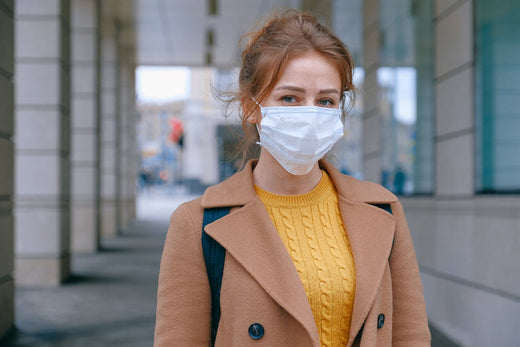What is Human Metapneumovirus (hMPV): Symptoms, Treatment & Prevention

We all know the feeling: that tickle in your throat, the gradual onset of a cough, and maybe even a fever. While the common cold often gets the blame, another sneaky culprit might be lurking – Human Metapneumovirus (hMPV).
This respiratory virus, often mistaken for other illnesses, can cause a range of symptoms, from mild sniffles to severe pneumonia, particularly in young children and the elderly.
Let's Delve into the World of hMPV Virus:
What is hMPV?
Who is at risk?
What are the symptoms?
How is hMPV diagnosed?
How is hMPV treated?
How can you prevent hMPV infection?
What is hMPV?
hMPV is a common respiratory virus that belongs to the family of paramyxoviruses. Like many other respiratory viruses, it spreads easily through respiratory droplets when an infected person coughs or sneezes.
Who is at risk?
While anyone can be infected with hMPV, certain groups are at higher risk for severe illness:
Infants and young children: Their immune systems are still developing, making them more susceptible to severe infections.
Older adults: Weakened immune systems in older adults can increase the risk of complications.
People with weakened immune systems: Individuals with conditions like HIV/AIDS, cancer, or those undergoing immunosuppressive therapy are more vulnerable.
Premature infants: These infants have underdeveloped lungs and may have difficulty fighting off infections.
What are the symptoms?
hMPV symptoms can vary greatly in severity, ranging from mild to severe. Common symptoms include:
Runny nose
Cough
Fever
Wheezing
Difficulty breathing
Irritability
Loss of appetite
In severe cases, hMPV can lead to:
Bronchiolitis: Inflammation of the small airways in the lungs
Pneumonia: Infection of the lungs
Origin and Global Spread of hMPV
Human Metapneumovirus (hMPV) was first identified in the Netherlands in 2001.
Discovery: Dutch virologists discovered hMPV while investigating respiratory infections in children that couldn't be attributed to known pathogens.
Evolutionary Origins:
hMPV is closely related to avian metapneumovirus (AMPV), suggesting a possible zoonotic origin.
It's believed that hMPV may have evolved from an avian ancestor and crossed over into humans.
Global Spread: Since its discovery, hMPV has been recognized as a significant cause of respiratory infections worldwide.
It's now known to circulate globally, affecting people of all ages, although young children and the elderly remain at higher risk for severe illness.
How is hMPV diagnosed?
Diagnosing hMPV can be challenging as its symptoms often overlap with other respiratory illnesses like the common cold and influenza. However, your doctor may use the following methods:
Nasal swab:
A sample of mucus is collected from the nose and tested for the presence of the hMPV virus.
Rapid diagnostic tests:
These tests can quickly detect the presence of hMPV in nasal swabs.
Chest X-ray:
In severe cases, a chest X-ray may be performed to check for pneumonia.
How is hMPV treated?
There is no specific antiviral treatment for hMPV. Treatment focuses on relieving symptoms and preventing complications. This may include:
Rest: Getting plenty of rest helps the body recover.
Fever reducers: Medications like acetaminophen or ibuprofen can help reduce fever.
Nasal saline drops: These can help loosen mucus and make it easier to clear.
Humidifier: Using a cool-mist humidifier can help soothe irritated airways.
In severe cases, hospitalization may be necessary, especially for infants and young children.
How to prevent hMPV infection?
While there is no specific vaccine for hMPV, several preventive measures can help reduce your risk of infection:
Frequent handwashing: Wash your hands frequently with soap and water, especially after coughing, sneezing, or using the bathroom.
Cover coughs and sneezes: Use a tissue to cover your mouth and nose when coughing or sneezing. If a tissue is not available, cough or sneeze into your elbow.
Avoid close contact: Stay away from people who are sick.
Disinfect surfaces: Regularly disinfect frequently touched surfaces, such as doorknobs, countertops, and toys.
Stay up-to-date on vaccinations: Getting vaccinated against other respiratory viruses, such as influenza, can help reduce the risk of severe illness.
Living with hMPV
If you or your child is diagnosed with hMPV, follow your doctor's instructions carefully. Get plenty of rest, stay hydrated, and use over-the-counter medications to relieve symptoms as directed.
When to see a doctor
Contact your doctor immediately if you or your child experiences any of the following:
Difficulty breathing
Rapid breathing
Bluish discoloration of the skin
High fever
Dehydration
The Importance of Awareness
Understanding hMPV is crucial for protecting yourself and your loved ones. By practicing good hygiene, staying informed, and seeking medical attention when necessary, you can minimize the impact of this sneaky virus.





